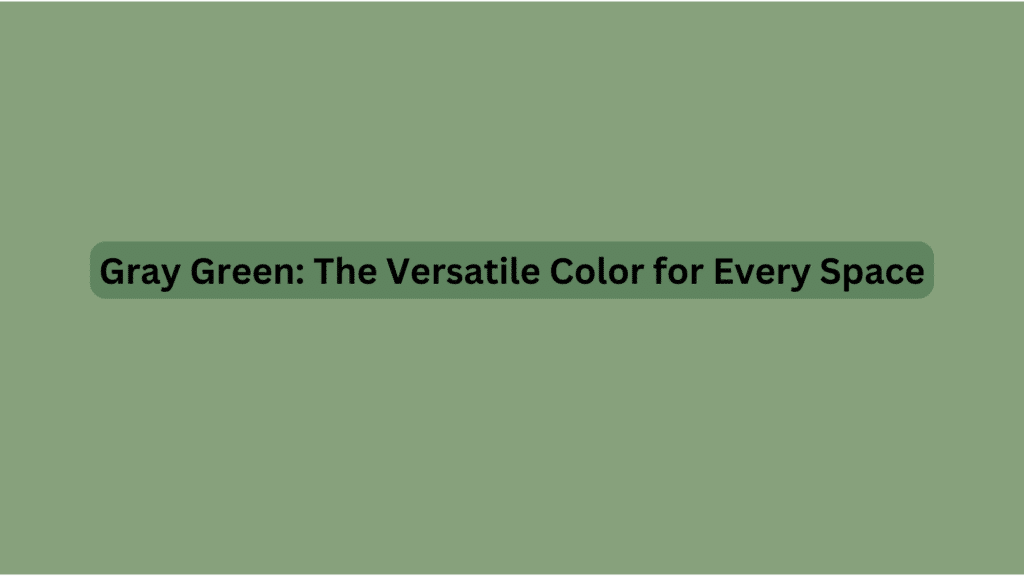Gray-green is one of those colors that can quietly transform a room without taking over. It feels calm, grounded, and balanced. It combines the peaceful side of green with the softness of gray, making it a great choice for all kinds of spaces—from bedrooms to kitchens and even bathrooms.
If you’ve been thinking about adding some color to your home but still want to keep things quiet and simple, gray-green might be exactly what you’re looking for.
This blog will walk you through what gray-green really is, how it works in different rooms, and how to choose the right shade. We’ll also talk about matching colors and finishes and the best ways to test it in your space.
What Is Gray Green Color, Really?

Gray-green is a soft mix of gray and green—yes, you guessed it—but it’s not just a 50/50 blend. Some shades lean more green.
Others feel more gray. Some are warm, and others are cool. What makes gray-green so useful is its quiet nature. It gives just enough color to make a space feel fresh and calm but not enough to overwhelm the eye.
This color works well in both old and new homes. It feels grounded and natural, like moss, sage, or eucalyptus. But because of the gray mixed in, it can also feel modern and clean.
Why People Love Gray Green
There’s a reason gray-green has become more popular in recent years. It fits into almost any home style, and it can be used with rustic woods or sleek cabinets.
It works with metal, clay, stone, or soft fabrics. It feels warm and welcoming in one room and clean and cool in another.
It also changes with the light. In the morning, it might feel soft and airy. In the evening, it can feel deep and rich. That makes it a great color for people who want something that stays interesting but is not loud.
Popular Gray Green Paint Colors
Let’s look at some well-known gray-green paint names that homeowners and designers love.
1. Sherwin-Williams Comfort Gray-SW 6205
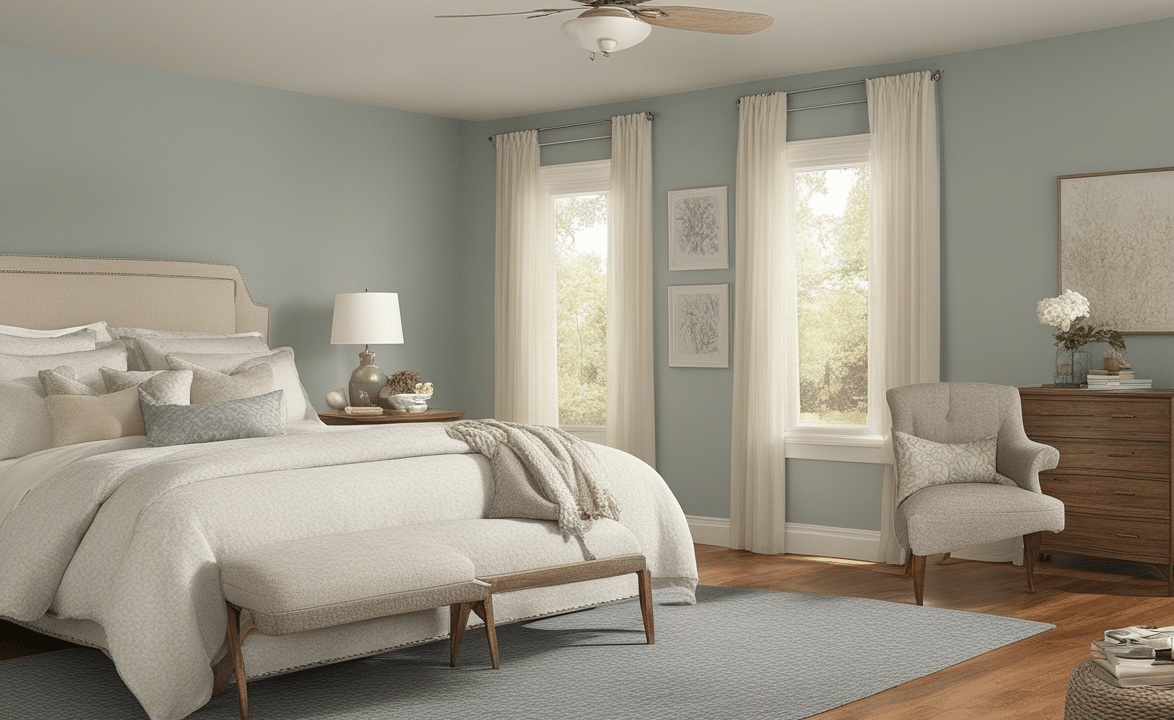
This color leans a bit more green but has enough gray to keep it soft. It’s popular in bathrooms and bedrooms because it feels peaceful.
2. Sherwin-Williams Oyster Bay-SW 6206
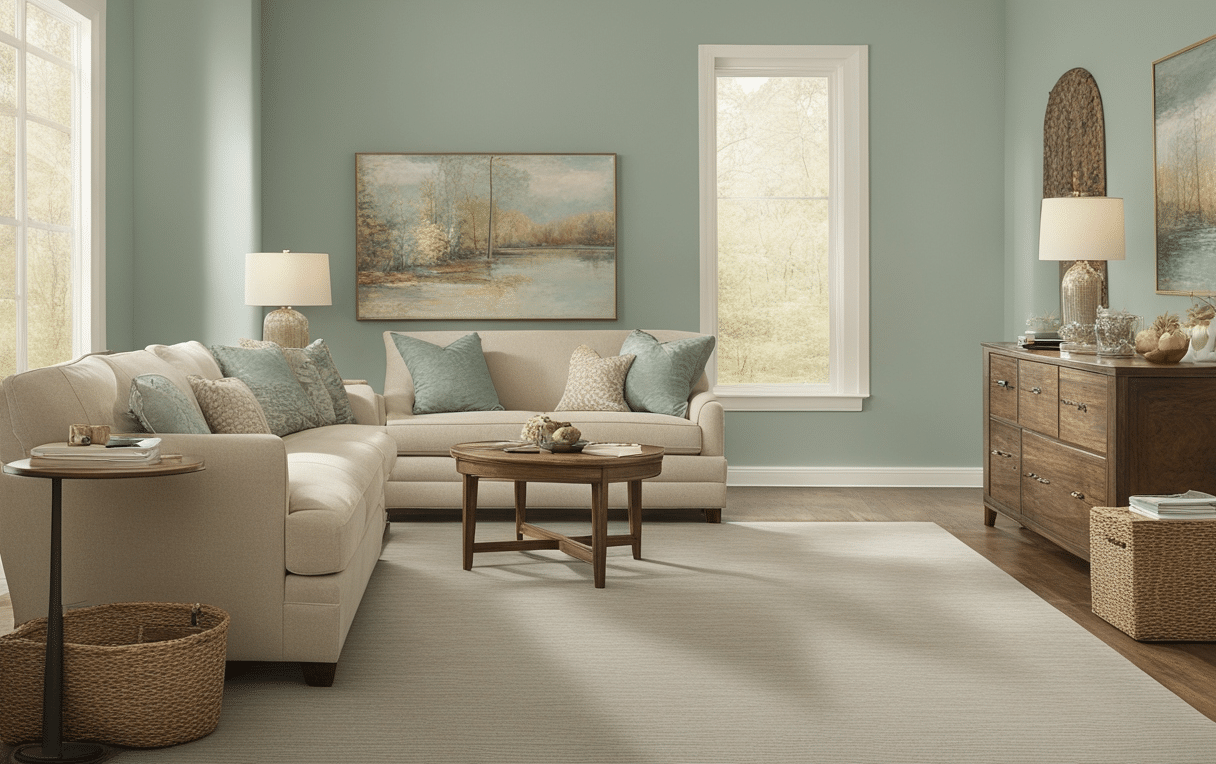
Darker than Comfort Gray, Oyster Bay has a stronger green presence. It works well with wood and other natural textures.
3. Benjamin Moore Saybrook Sage-HC 114
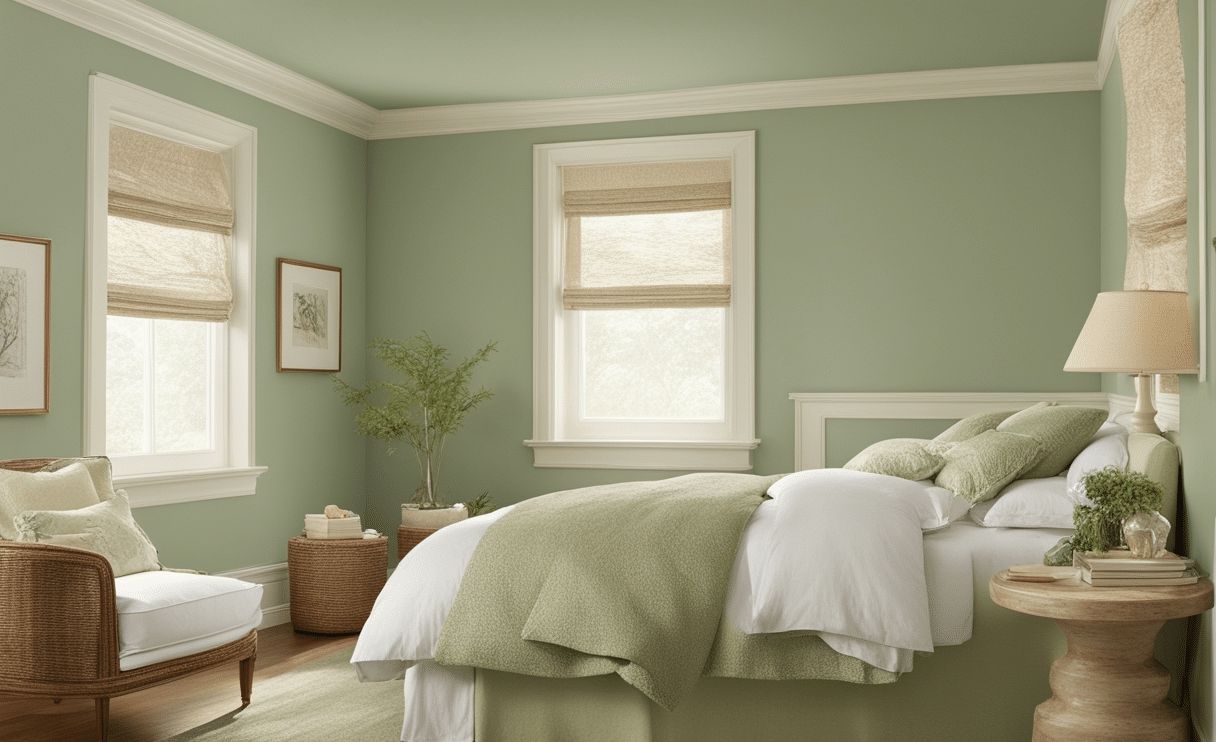
This shade feels more classic. It has a strong green base with a bit of gray to tone it down. It’s often used in older homes or for a cottage feel.
4. Benjamin Moore October Mist-1495
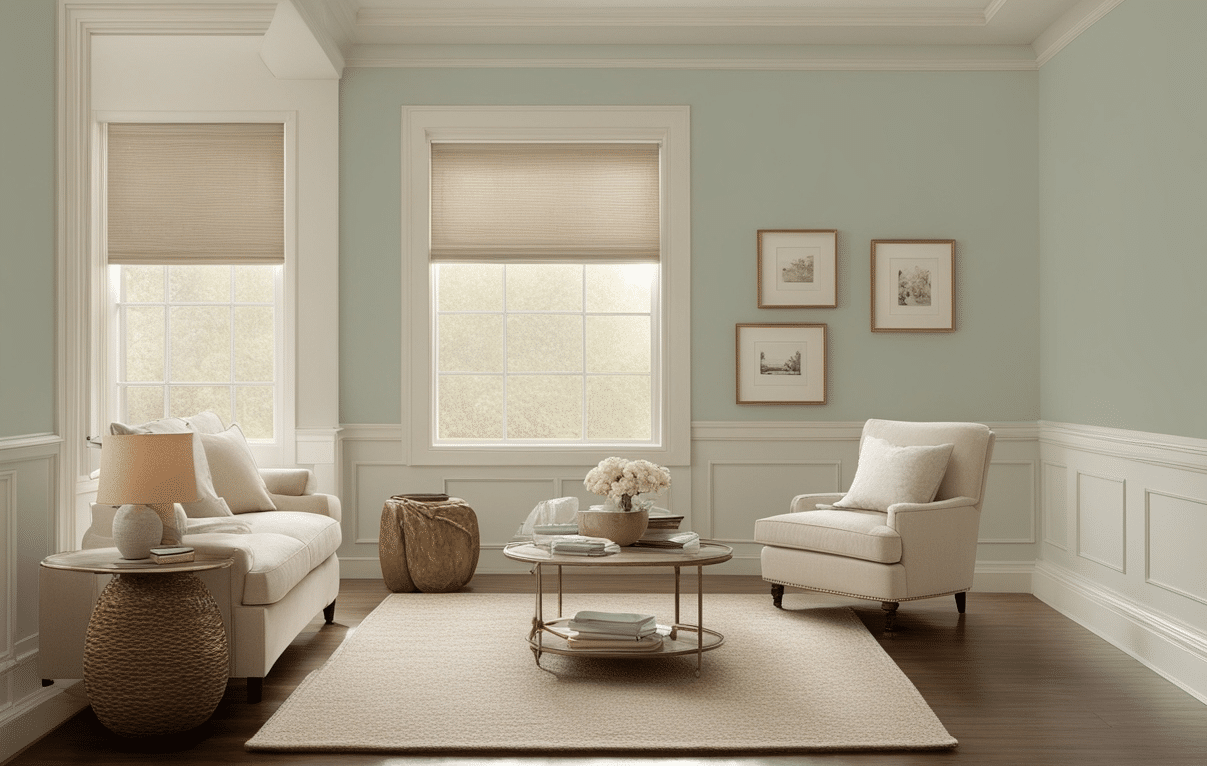
October Mist is more muted. It’s part of Benjamin Moore’s modern lineup and fits well with neutral palettes. It gives off a plant-like, soft mood.
5. Farrow & Ball Mizzle-266
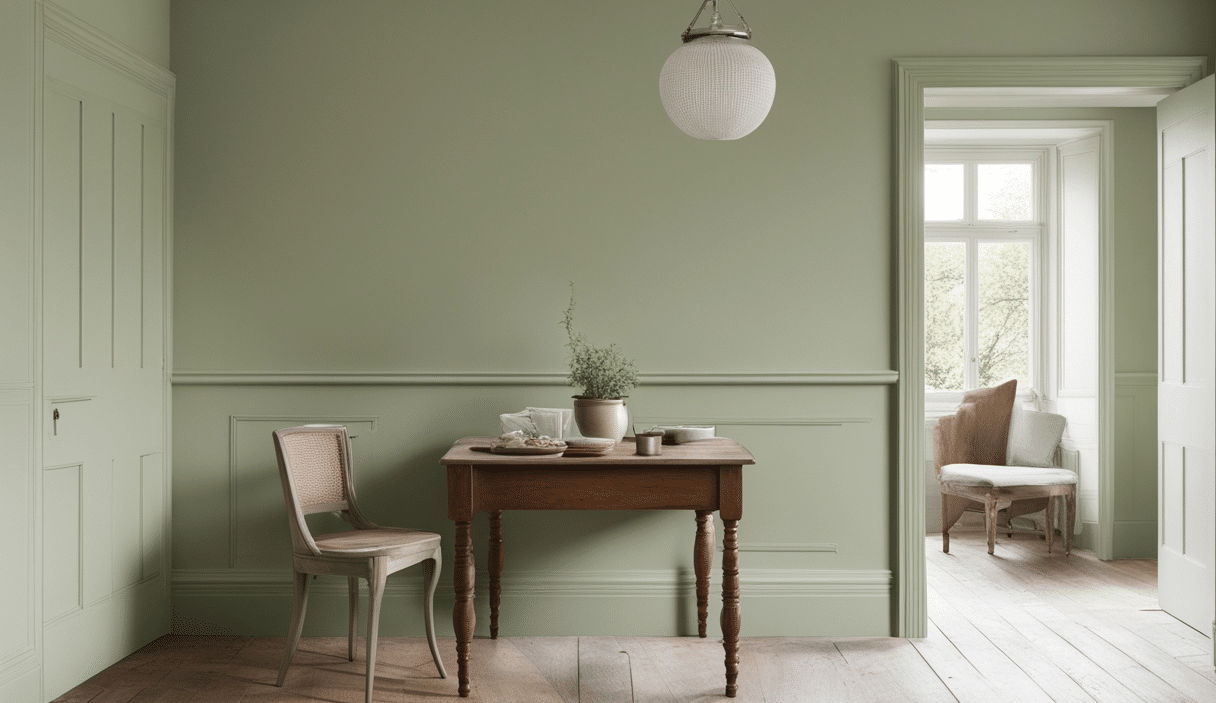
A gentle gray-green with an earthy tone. It’s subtle, classy, and works nicely in rooms that get a lot of natural light.
Where Gray Green Works Best
This color works in almost every part of the house. Let’s explore how it feels in each room.
Living Room
A gray-green living room feels peaceful and easy to be in. If your space has lots of wood or natural textures, gray-green will help tie it all together. Try pairing it with light cream or off-white for a cozy setup. If you want a more modern touch, add black or deep charcoal furniture.
Bedroom
This color is a great choice for bedrooms. It feels calming and helps you wind down at the end of the day, whether your furniture is dark wood, soft linen, or simple white. Gray-green acts like a soft hug around the space.
Bathroom
Want that spa-like feel? Gray-green works wonders in bathrooms. It looks great with white tile, marble, or matte black hardware. It makes the room feel clean but not cold.
Kitchen
You can use gray-green on cabinets or even walls. It brings color into the kitchen without shouting for attention. Paired with gold hardware or butcher-block counters, it gives a soft, lived-in look. If your kitchen has a lot of light, this color can make it feel fresh and open.
Dining Room
In dining areas, gray-green adds depth. It helps set the mood without taking away from your table setting. Candlelight and natural wood look especially nice against gray-green walls.
Hallways and Entryways
These often-forgotten areas are perfect for gray-green. It helps create a smooth flow between rooms, especially if you’re using white or beige elsewhere in the house.
Warm vs. Cool Gray Greens
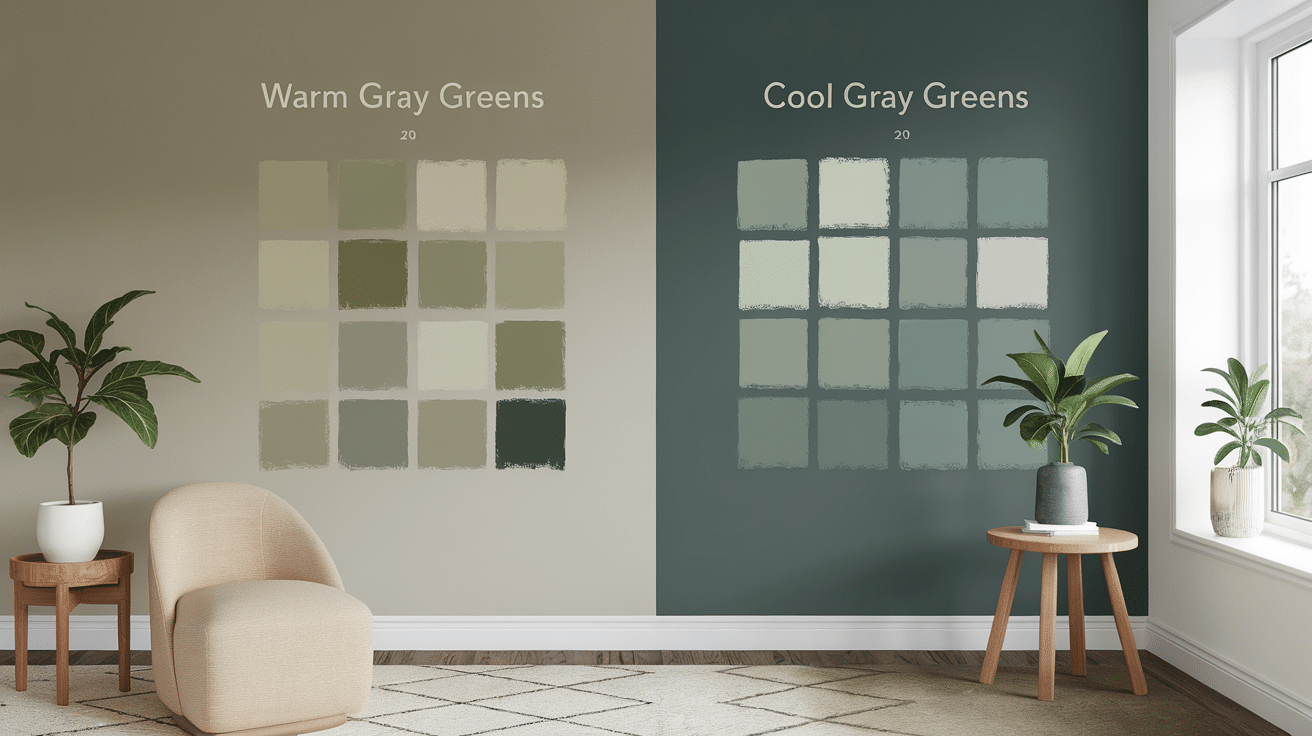
Not all gray greens are the same. Some are warmer, with yellow or brown undertones. Others are cooler, with blue or silver hints. Here’s how to tell which one you need:
If your home has warm wood, brass finishes, or creamy tones, a warm gray-green will feel more natural.
If your space includes cool grays, stainless steel, or bright whites, a cooler gray-green will blend better.
One easy way to test this is to hold a paint sample up next to your flooring, cabinets, or furniture. If it feels “off,” try switching undertone types.
How Gray Green Changes in Different Light
Light matters more than you think. Gray-green can look completely different depending on the time of day or the kind of bulbs you use.
In natural light, it might look greener in the morning and grayer in the evening. In low light, it may appear a bit more muted. That’s why it’s smart to test samples and look at them at different times throughout the day.
Cool LED lights might make the green side more noticeable, while warm bulbs may bring out the gray and earthy parts.
What Colors Go Well with Gray Green?
This color is easy to pair with others, but it helps to think in themes.
If you’re going for a soft, clean look, try pairing it with off-white, warm cream, or a gentle beige. These combos create a peaceful vibe that’s great for relaxing spaces.
If you want a bolder contrast, black, charcoal, or deep navy all pair well with gray-green. These choices work better for kitchens, offices, or more modern styles.
Blush pink, muted gold, or terracotta also look great with gray-green, giving the space a natural, grounded feel.
Tips for Testing Gray Green Paint
Before you paint the whole room, test it first.
Start by getting a few sample pots. Paint each one on a large piece of white poster board. Use two coats so the color shows up clearly.
Move the boards around your room during the day and under different lights. See how they look next to your floors, furniture, and trim.
Spend at least 1–2 days observing the samples. Don’t rush it. A color that looks perfect in the store might feel completely different in your space.
Is Gray Green the Right Color for You?
If you want a soft, natural, and easy-to-live-with color, gray-green is a great option. It doesn’t scream for attention; it quietly supports the rest of your space.
It fits both classic and modern styles. It works with wood, stone, tile, and metal. It feels calm without being boring. And best of all—it’s not a trend that will go out of style next year.
It’s a safe, smart choice if you want a room that feels relaxing, lived-in, and well-balanced.
Conclusion
Gray-green is one of those rare colors that can do a little bit of everything. It’s soft enough to use all over a room but rich enough to stand alone.
It works with a wide mix of other colors and styles. Whether you’re redoing a whole house or just one room, gray-green gives you the freedom to keep things simple or add layers of depth.
This color brings a natural feel indoors. It doesn’t try too hard. It just quietly makes the space feel right. If you’re still not sure what color to choose, try a few gray green samples—and let the color speak for itself.
Frequently Asked Questions
What kind of color is gray-green?
Gray-green is a soft mix of green and gray. It’s calm, balanced, and easy to use in many rooms.
Is gray-green warm or cool?
It can be both. Some shades lean warm with brown or yellow tones. Others lean cool with blue or silver undertones. It depends on the brand and color name.
Where can I use gray-green in my home?
You can use it anywhere—living rooms, bedrooms, bathrooms, kitchens, hallways. It’s that flexible.
Does gray-green go with white?
Yes. It looks great with both warm and cool whites. Just be sure the white trim you use fits with the undertone of the gray-green you pick.
Will gray-green look too dark in small rooms?
Some darker shades might work, but lighter ones like October Mist or Comfort Gray usually work well. Always test a sample to be sure.

